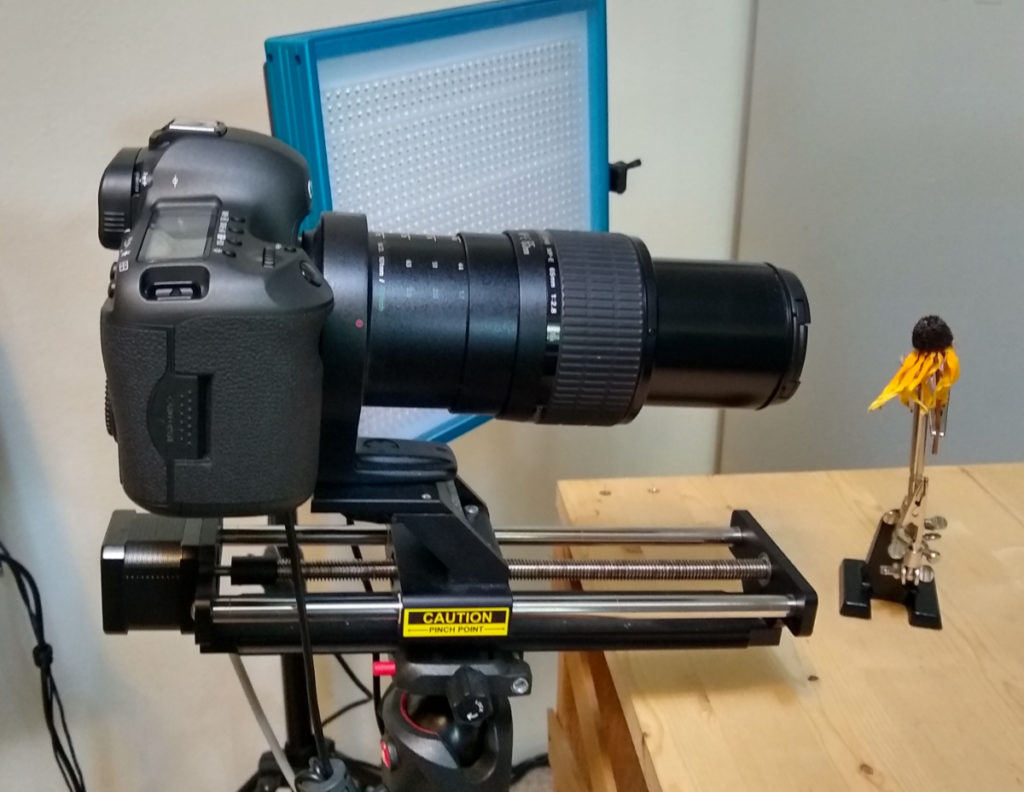Focus stacking uses software to “stack” multiple pictures into one picture. The pictures are taken at different focal distances. Lenses have a limited depth of field. This means that there is a minimum distance and a maximum distance for which the picture is in focus. Macro lenses tend to have a very small depth of field, usually a small fraction of an inch. By taking pictures at different distances, you are, in some sense, taking pictures that are slices of focus. Although this is most commonly used for macro photography, it can be used at any scale and there are some gorgeous landscape pictures with flowers in the front and mountains in the back – with everything in focus.
The software aligns the pictures and identifies the parts of each picture that are in focus and uses these parts to create a final picture that has a very sharp focus, potentially over the entire picture. (I use Zerene Stacker. http://zerenesystems.com/cms/stacker.) As shown in the picture, the camera is placed on a focus rail (an automated, powered, stepper) which allows the camera to be physically moved through the focal distances. Most of my images are constructed by stacking about 100 – 200 photos, although I have used over 600 photos for a single image. The reason for so many photos is that the depth of field (how much is in focus) at high lens magnifications can be small. When shooting at 5X magnification, I use steps of about 50 micrometers (0.002 inches.) So it takes 500 frames to achieve a 1 inch focal depth at this magnification. I also use the soldering “third hand” shown in the picture to give me the 6 degrees of freedom I need to position the flower. (It is also possible to simply use the focusing ring on the lens itself and I sometimes do this depending on the lens and the subject.)
Excellent tutorials on focus stacking are provided by Michael Erlewine at http://spiritgrooves.net/Photography.aspx. I especially like his comment that focus stacking transfers the decision of where to focus from the photographer to the viewer. In traditional photography the photographer very much chooses the main point of focus, especially when portions of the picture are out of focus. Although the photographer still plays a part in this when using focus stacking simply by framing and artistic design, with the entire picture in focus, the viewer has the option of looking anywhere they wish.

- Flowers
- August 2022
- July 2021
- Passion Flower (passiflora caerulea)
- June 2020
- Surreal (Macro)
- Abstract (Macro)
- Dried and Nonflowers
- Stamens and Pistils
- Flower Closeups & Macros
- Full Flowers
- Oregon Wildflowers
- Travel
- Antarctica (Dec 2016)
- Antarctic Abstracts (Dec 2016)
- Solar Eclipse (Aug 21, 2017)
- Landscapes and Cloudscapes (May 2016)
- General Info
- Pricing and Framing
- Artistic Influences
- Focus (Photo) Stacking
- Magnification & Enlargement
- Exhibits
- Equipment and Sofware
- Navigating Galleries
- Mobile vs. Desktop